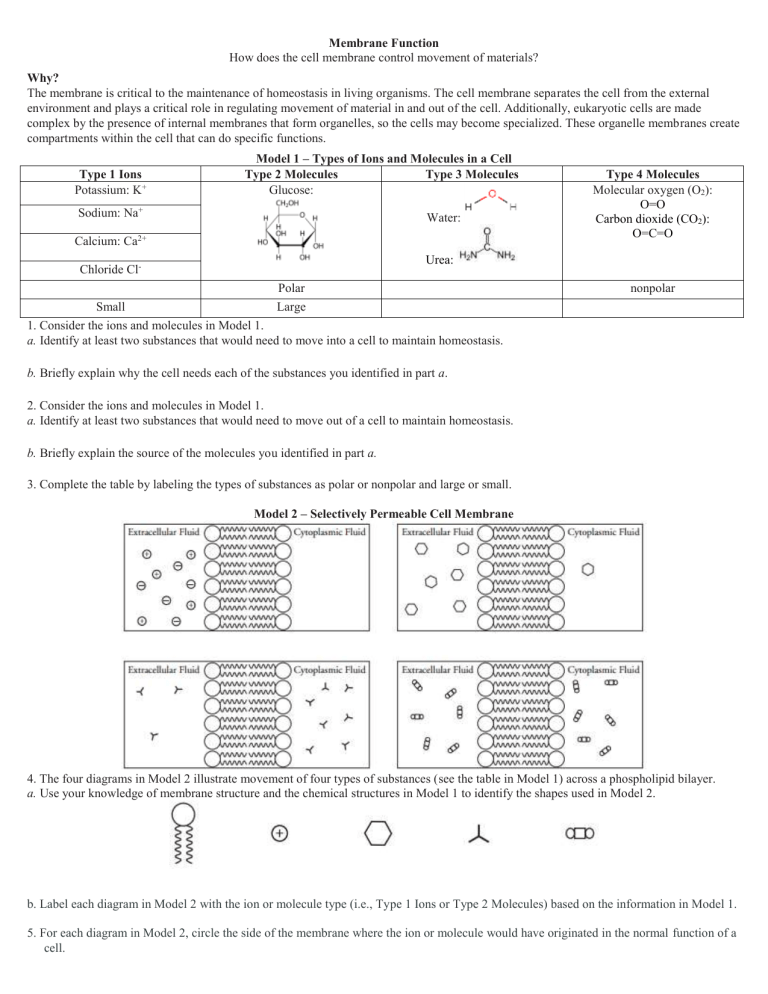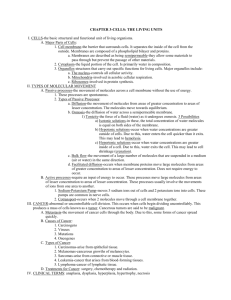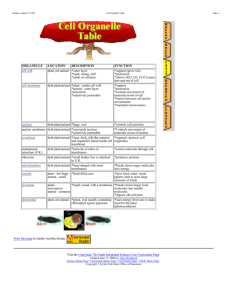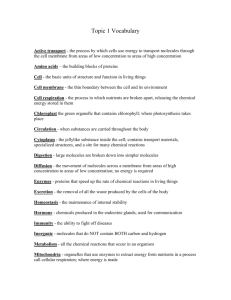Membrane Function How does the cell membrane control movement

Membrane Function
How does the cell membrane control movement of materials?
Why?
The membrane is critical to the maintenance of homeostasis in living organisms. The cell membrane separates the cell from the external environment and plays a critical role in regulating movement of material in and out of the cell. Additionally, eukaryotic cells are made complex by the presence of internal membranes that form organelles, so the cells may become specialized. These organelle membranes create compartments within the cell that can do specific functions.
Type 1 Ions
Potassium: K
Sodium: Na +
+
Model 1 – Types of Ions and Molecules in a Cell
Type 2 Molecules Type 3 Molecules
Glucose:
Water:
Type 4 Molecules
Molecular oxygen (O
2
):
O=O
Carbon dioxide (CO
2
):
O=C=O
Calcium: Ca 2+
Urea:
Chloride Cl -
Polar
Small Large
1. Consider the ions and molecules in Model 1. a. Identify at least two substances that would need to move into a cell to maintain homeostasis. b. Briefly explain why the cell needs each of the substances you identified in part a .
2. Consider the ions and molecules in Model 1. a. Identify at least two substances that would need to move out of a cell to maintain homeostasis. b. Briefly explain the source of the molecules you identified in part a.
3. Complete the table by labeling the types of substances as polar or nonpolar and large or small.
Model 2 – Selectively Permeable Cell Membrane nonpolar
4. The four diagrams in Model 2 illustrate movement of four types of substances (see the table in Model 1) across a phospholipid bilayer. a. Use your knowledge of membrane structure and the chemical structures in Model 1 to identify the shapes used in Model 2. b. Label each diagram in Model 2 with the ion or molecule type (i.e., Type 1 Ions or Type 2 Molecules) based on the information in Model 1.
5. For each diagram in Model 2, circle the side of the membrane where the ion or molecule would have originated in the normal function of a cell.
6. Assume the substances in Model 2 were on only one side of the membrane to start. The diagrams illustrate what would happen after some time has passed. a. Which substances in Model 2 appear to be completely blocked by the membrane? b. Which substances in Model 2 appear to be able to pass freely through the membrane? c. Which substances in Model 2 appear to pass through the membrane with some difficulty? d. Urea appears to pass through the membrane more easily than glucose. What characteristic of urea might help explain this observation?
7. The majority of the membrane is made of nonpolar hydrocarbon chains. Use the diagrams in Model 2 and the table in Model 1 to explain the permeability of the membrane for each of the four types of substances in Model 1. Hint: Like dissolves like.
Type 1 Ions:
Type 2 Molecules (Large, polar biomolecules):
Type 3 Molecules (Small, polar molecules):
Type 4 Molecules (Small, nonpolar molecules):
Read This!
Diffusion is the process of molecules traveling through a membrane barrier from a location of high concentration to a location of low concentration. The driving force for this process is simply the natural movement of the molecules in random directions. Whether the molecules are allowed to cross or not is only due to the polarity of the molecules themselves and their size. No energy is needed, which is why diffusion is considered a type of passive transport. This process is illustrated in Model 2 for several types of molecules.
Model 3 – Embedded Proteins
8. Label the embedded proteins in the membrane diagrams of Model 3.
9. What appears to be the effect of inserting a protein channel into the membrane on the movement of molecules across the membrane?
10. Is the inner surface of the embedded protein likely to be polar or nonpolar in the examples shown in Model 3? Explain your reasoning.
Read This!
When an embedded protein assists in the passive transport of molecules across a barrier in the direction of the concentration gradient (from high concentration to low concentration) it is called facilitated diffusion . Embedded proteins may also be involved in active transport where the cell uses energy from ATP to move molecules across a membrane against the concentration gradient.
11. Summarize the two types of passive transport discussed above. In your answer consider the types of molecules that are transported, the direction of transport, and any external energy or special structures that are needed in the process.
12. Summarize active transport. In your answer consider the direction of transport and any external energy or special structures that are needed in the process.
Extension Questions
13. Some embedded proteins are called aquaporins . What molecule do you think aquaporins assist in transporting across a membrane?
14. The molecules below are often moved into or out of cells during biological processes. Categorize each molecule into one of the four types
(from Model 1). Using that classification decide whether or not they would be able to cross the cell membrane freely without the help of a membrane protein.
Nitrogen gas
N
2
Hydronium
H
3
O +
Alanine (amino acid) Sucrose Bicarbonate








